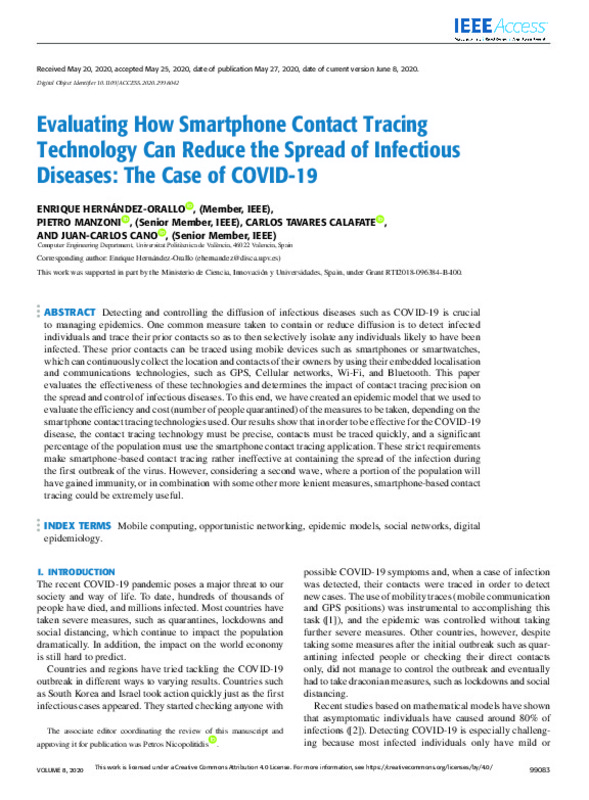JavaScript is disabled for your browser. Some features of this site may not work without it.
Buscar en RiuNet
Listar
Mi cuenta
Estadísticas
Ayuda RiuNet
Admin. UPV
Evaluating How Smartphone Contact Tracing Technology Can Reduce the Spread of Infectious Diseases: The Case of COVID-19
Mostrar el registro sencillo del ítem
Ficheros en el ítem
| dc.contributor.author | Hernández-Orallo, Enrique
|
es_ES |
| dc.contributor.author | Manzoni, Pietro
|
es_ES |
| dc.contributor.author | Tavares De Araujo Cesariny Calafate, Carlos Miguel
|
es_ES |
| dc.contributor.author | Cano, Juan-Carlos
|
es_ES |
| dc.date.accessioned | 2021-03-10T04:31:18Z | |
| dc.date.available | 2021-03-10T04:31:18Z | |
| dc.date.issued | 2020 | es_ES |
| dc.identifier.uri | http://hdl.handle.net/10251/163577 | |
| dc.description.abstract | [EN] Detecting and controlling the diffusion of infectious diseases such as COVID-19 is crucial to managing epidemics. One common measure taken to contain or reduce diffusion is to detect infected individuals and trace their prior contacts so as to then selectively isolate any individuals likely to have been infected. These prior contacts can be traced using mobile devices such as smartphones or smartwatches, which can continuously collect the location and contacts of their owners by using their embedded localisation and communications technologies, such as GPS, Cellular networks, Wi-Fi, and Bluetooth. This paper evaluates the effectiveness of these technologies and determines the impact of contact tracing precision on the spread and control of infectious diseases. To this end, we have created an epidemic model that we used to evaluate the efficiency and cost (number of people quarantined) of the measures to be taken, depending on the smartphone contact tracing technologies used. Our results show that in order to be effective for the COVID-19 disease, the contact tracing technology must be precise, contacts must be traced quickly, and a significant percentage of the population must use the smartphone contact tracing application. These strict requirements make smartphone-based contact tracing rather ineffective at containing the spread of the infection during the first outbreak of the virus. However, considering a second wave, where a portion of the population will have gained immunity, or in combination with some other more lenient measures, smartphone-based contact tracing could be extremely useful. | es_ES |
| dc.description.sponsorship | This work was supported in part by the Ministerio de Ciencia, Innovacion y Universidades, Spain, under Grant RTI2018-096384-B-I00. | es_ES |
| dc.language | Inglés | es_ES |
| dc.publisher | Institute of Electrical and Electronics Engineers | es_ES |
| dc.relation.ispartof | IEEE Access | es_ES |
| dc.rights | Reconocimiento (by) | es_ES |
| dc.subject | Mobile computing | es_ES |
| dc.subject | Opportunistic networking | es_ES |
| dc.subject | Epidemic models | es_ES |
| dc.subject | Social networks | es_ES |
| dc.subject | Digital epidemiology | es_ES |
| dc.subject.classification | ARQUITECTURA Y TECNOLOGIA DE COMPUTADORES | es_ES |
| dc.title | Evaluating How Smartphone Contact Tracing Technology Can Reduce the Spread of Infectious Diseases: The Case of COVID-19 | es_ES |
| dc.type | Artículo | es_ES |
| dc.identifier.doi | 10.1109/ACCESS.2020.2998042 | es_ES |
| dc.relation.projectID | info:eu-repo/grantAgreement/AEI/Plan Estatal de Investigación Científica y Técnica y de Innovación 2017-2020/RTI2018-096384-B-I00/ES/SOLUCIONES PARA UNA GESTION EFICIENTE DEL TRAFICO VEHICULAR BASADAS EN SISTEMAS Y SERVICIOS EN RED/ | es_ES |
| dc.rights.accessRights | Abierto | es_ES |
| dc.contributor.affiliation | Universitat Politècnica de València. Departamento de Informática de Sistemas y Computadores - Departament d'Informàtica de Sistemes i Computadors | es_ES |
| dc.description.bibliographicCitation | Hernández-Orallo, E.; Manzoni, P.; Tavares De Araujo Cesariny Calafate, CM.; Cano, J. (2020). Evaluating How Smartphone Contact Tracing Technology Can Reduce the Spread of Infectious Diseases: The Case of COVID-19. IEEE Access. 8:99083-99097. https://doi.org/10.1109/ACCESS.2020.2998042 | es_ES |
| dc.description.accrualMethod | S | es_ES |
| dc.relation.publisherversion | https://doi.org/10.1109/ACCESS.2020.2998042 | es_ES |
| dc.description.upvformatpinicio | 99083 | es_ES |
| dc.description.upvformatpfin | 99097 | es_ES |
| dc.type.version | info:eu-repo/semantics/publishedVersion | es_ES |
| dc.description.volume | 8 | es_ES |
| dc.identifier.eissn | 2169-3536 | es_ES |
| dc.relation.pasarela | S\413474 | es_ES |
| dc.contributor.funder | Agencia Estatal de Investigación | es_ES |








